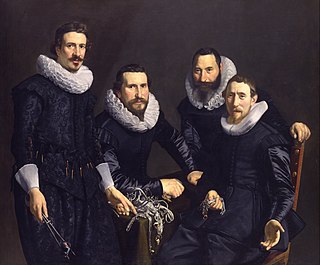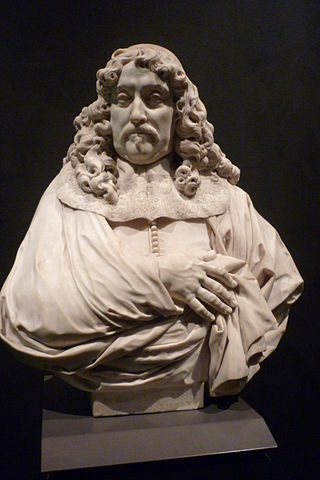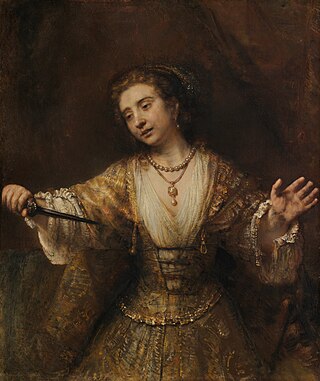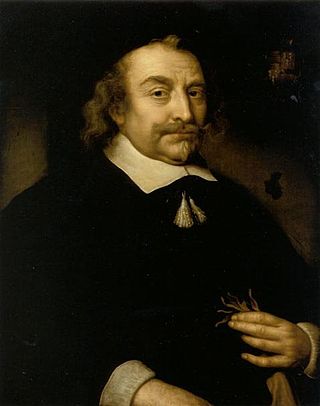
Johan de Witt was a Dutch statesman who was a major political figure during the First Stadtholderless Period, when flourishing global trade in a period of rapid European colonial expansion made the Dutch a leading trading and seafaring power in Europe, commonly referred to as the Dutch Golden Age. De Witt was elected Grand Pensionary of Holland, and together with his uncle Cornelis de Graeff, he controlled the Dutch political system from around 1650 until the Rampjaar of 1672. This progressive cooperation between the two statesmen, and the consequent support of Amsterdam under the rule of De Graeff, was an important political axis that organized the political system within the republic.

Thomas de Keyser was a Dutch portrait painter and a dealer in Belgium bluestone and stone mason. He was the most in-demand portrait painter in the Netherlands until the 1630s, when Rembrandt eclipsed him in popularity. Rembrandt was influenced by his work, and many of de Keyser's paintings were later falsely attributed to Rembrandt.

Bartholomeus van der Helst was a Dutch painter. Considered to be one of the leading portrait painters of the Dutch Golden Age, his elegant portraits gained him the patronage of Amsterdam's elite as well as the Stadtholder's circle. Besides portraits, van der Helst painted a few genre pictures as well as some biblical scenes and mythological subjects.

This is a chronology of the artist Vincent van Gogh. It is based as far as possible on Van Gogh's correspondence. However, it has only been possible to construct the chronology by drawing on additional sources. Most of his letters are not dated and it was only in 1973 that a sufficient dating was established by Jan Hulsker, subsequently revised by Ronald Pickvance and marginally corrected by others. Many other relevant dates in the chronology derive from the biographies of his brother Theo, his uncle and godfather Cent, his friends Émile Bernard and Paul Gauguin, and others.

Gerard or Gérard (de) Lairesse was a Dutch Golden Age painter and art theorist. His broad range of skills included music, poetry, and theatre. De Lairesse was influenced by the Perugian Cesare Ripa and French classicist painters such as Charles le Brun, Simon Vouet and authors such as Pierre Corneille and Jean Racine. His importance grew in the period following the death of Rembrandt. His treatises on painting and drawing, Grondlegginge Ter Teekenkonst (1701), based on geometry and Groot Schilderboek (1707), were highly influential on 18th-century painters.

Artus Quellinus the Elder, Artus Quellinus I or Artus (Arnoldus) Quellijn was a Flemish sculptor. He is regarded as the most important representative of the Baroque in sculpture in the Southern Netherlands. He worked for a long period in the Dutch Republic and operated large workshops both in Antwerp and Amsterdam. His work had a major influence on the development of sculpture in Northern Europe.

Jan Jansz. Vos was a Dutch playwright and poet. A glassmaker by trade, he also played an important role as stage-manager and director of the theatre. He organized, on the mayors' orders, processions and splendid decorated floats, which sometimes drew disapproval, criticism, and derision.

Cornelis de Graeff, often named Polsbroek or de heer van (lord) Polsbroek during his lifetime, was an influential regent and burgomaster (mayor) of Amsterdam, statesman and diplomat of Holland and the Republic of the United Netherlands at the height of the Dutch Golden Age.

Catharina Pietersdr Hooft was a woman of the Dutch Golden Age. She became famous at a very early age, when she was painted by Frans Hals.

Susanna van Steenwijk was a painter of small architectural exteriors active in Leiden and Amsterdam.

De Graeff is a Dutch noble family.

Andries de Graeff was a regent and burgomaster (mayor) of Amsterdam and leading Dutch statesman during the Golden Age.

Gerard Brandt was a Dutch preacher, playwright, poet, church historian, biographer and naval historian. A well-known writer in his own time, his works include a Life of Michiel de Ruyter and a Historie der vermaerde zee- en koopstadt Enkhuisen.

Pieter de Graeff was a Dutch aristocrat of the Dutch Golden Age and one of the most influential pro-state, republican Amsterdam Regents during the late 1660s and the early 1670s before the Rampjaar 1672. As president-bewindhebber of the Dutch East India Company, he was one of the most important representatives and leaders of the same after the Rampjaar.

Jacob Dircksz de Graeff, free lord of Zuid-Polsbroek was an illustrious member of the Dutch patrician De Graeff family. He belonged to States Faction and was an influential Amsterdam regent and burgomaster (mayor) of the Dutch Golden Age.
Andries is a Dutch and Afrikaans masculine given name or surname equivalent to Andrew.

Lucretia is a 1664 history painting of Roman noblewoman Lucretia, historically attributed to the Dutch Golden Age painter Rembrandt in the collection of the National Gallery of Art. In 2015, Ernst van de Wetering of the Rembrandt Research Project said that "the formal properties and execution of [this] painting, I am convinced, exclude the possibility that it could be an autograph work by Rembrandt", and that the painting recalls Aert de Gelder. The painting is not included in the project's 2015 Rembrandt corpus.

Cornelis Bicker van Swieten, heer (lord) van Swieten, was an Amsterdam regent of the Dutch Republic during the Golden Age. He traded in sugar, was a governor of the Dutch West India Company and director of the Wisselbank. He was schepen, hoogheemraad of the Hoogheemraadschap van Rijnland and a counsellor of the States of Holland and West Friesland at The Hague.

Het kasteel van Batavia is a 17th-century painting by the Dutch painter Andries Beeckman. The painting depicts the Batavia Castle, the headquarter of the Dutch East India Company located in what is now Kota Tua in Jakarta, Indonesia. The painting is currently displayed in the Rijksmuseum in Amsterdam.

The Boelens and Boelens Loen were a Dutch patrician family of Amsterdam. The family figured in the city's government lists between the years 1360 and 1680. They were considered to be quite an influential Amsterdam family in their time and were intensely involved in the history of their hometown. Between 1495 and 1538 the oligarchy of the so-called Boelen-Heijnen clan was at the forefront of the Amsterdam city government.





















